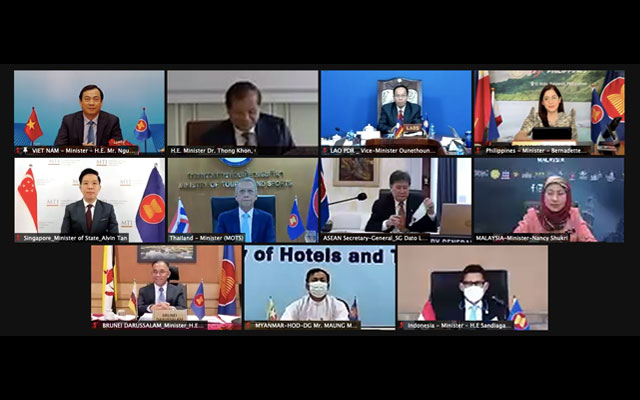The ASEAN Tourism Association (ASEANTA) has urged Southeast Asian leaders to take urgent action to restart the travel and tourism industries in the region by the second quarter of this year and to keep the tourism industry from collapsing under the weight of the pandemic to preserve.
During the recent 24th ASEAN Tourism Ministers’ Meeting, held practically last week and hosted by Cambodia, ASEANTA made a number of recommendations to ministers, including continuing to support their respective governments in a fair and equitable manner for survival secure the industry. This includes government guaranteed loans, tax breaks, subsidies, incentives and other relevant fiscal measures.
 24th meeting of ASEAN tourism ministers
24th meeting of ASEAN tourism ministers
The association also called on the respective governments to prepare for the reopening of the borders by establishing frameworks for cross-border travel, standard operating procedures (SOPs) for the entire tourism ecosystem and guidelines for testing and vaccination by the first quarter of this year. This also includes the possible development of a joint ASEAN health passport with the possible integration of existing apps for contact tracking or health declaration.
They also called on tourism ministers to facilitate resumption of all types of travel – including business, leisure and VFR travel – by the second quarter of this year under the ASEAN Travel Corridor Arrangement (TCA) framework.
The ASEAN TCA framework, issued last November by Southeast Asian leaders, aims to develop joint pre- and post-arrival health and safety measures, led by the Indonesian Ministry of Foreign Affairs. The development of ASEAN TCA would help resume cross-border travel by setting common requirements across borders.
As part of the ASEAN TCA, ASEANTA suggested that business travel corridors include the following security measures: pre-departure and arrival tests, self-isolation for just a day or two until the results of the PCR test are published on arrival, a controlled itinerary, or allowance for business travelers who want to travel for leisure as long as company sponsored and no quarantine for returning business travelers.
The association has also considered the option of quarantine-free travel bubbles to enable recreational and VFR travel between low-risk countries without imposing quarantine on both arriving and returning travelers. The plan would include the need for mutually recognized testing procedures as well as common vaccine documentation to facilitate review.
Business travel alone will not be enough to bring traffic within ASEAN back to healthy levels, ASEANTA said, noting that traffic within ASEAN accounts for 35 percent of all international O&D passenger traffic in Southeast Asia. It was also noted that the reciprocal green lane agreements (RGL) did not generate any significant volume of air traffic, citing official data showing that Singapore only had around 835 inbound travelers from the region between June 8 and December Southeast Asia under the RGL agreements received 25 last year.
If the border reopening is limited to essential business travel, passenger traffic between Southeast Asian countries will likely remain below five percent of normal for most of 2021, he added.
ASEANTA also highlighted the important role the travel and tourism sector plays in the Southeast Asian economy. In 2019, the travel and tourism sector contributed $ 380 billion, or 12.1 percent, to Southeast Asia’s GDP and created 42.3 million jobs, or 13.3 percent of total employment in the region.
